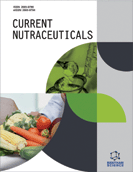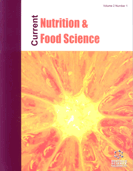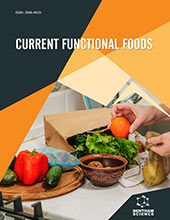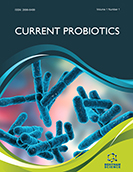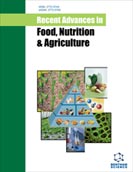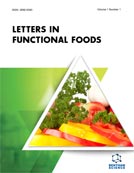Abstract
Background: Cancer is a homogenous group of diseases characterized by the dysregulation of normal cell physiological processes, such as proliferation, growth, and migration. In Mexico, cancer accounts for one of the main causes of death. Among the most common types of cancer which affect the Mexican population are breast, cervical, and colon cancers.
Objective: In the current research, we studied the effects of phenolic compounds of soy (Glycine max), isoflavones, available as a nutraceutical commercial product, on the proliferation of several cancer cell lines.
Methods: Firstly, we carried out a series of experiments of simulated chemical digestion to later determine the integrity and functionality of active compounds present in commercial capsule products after their chemical digestion. Later on, we performed thin-layer chromatography, ultraviolet/ visible spectrophotometry, and analysis of the antioxidant activity of the phenolic compounds. We also assessed the effects on the proliferation of several cancer cell lines.
Results: By using such techniques, we demonstrated that soy isoflavones maintained their integrity and activity, even after being chemically digested. Moreover, our results showed several cases in which soy isoflavones did exert a noticeable effect on cell proliferation. Though the IC50 doses were different for each cell line, cell proliferation was, in fact, lower in all of them.
Conclusion: Our research provides strong evidence of the compelling antiproliferative effect of soy isoflavones in the commercial product, even after simulated digestion, in distinct types of cancer. Hence, this represents a breakthrough to continue investigating phenolic compounds as potential coadjutants for anti-neoplastic treatments.
Keywords: Nutraceutical soy isoflavones, simulated digestion, microwave-assisted extraction, breast, colon, cervix hepatic adenocarcinoma, cancer cell lines.
Graphical Abstract
Current Nutraceuticals
Title:The Antiproliferative Effect of Soy (Glycine max) Isoflavones Contained in a Nutraceutical on Cancer Cell Lines
Volume: 2
Author(s): Maura Cárdenas-García*, Diana Jiménez-Hernández, María Guadalupe Hernández-Linares, Marcela Lucía Guerrero-Africani and Lilia Karina Cabrera-Cosme
Affiliation:
- Lab. Fisiologia Celular, Facultad de Medicina, BUAP, Puebla 72420,Mexico
Keywords: Nutraceutical soy isoflavones, simulated digestion, microwave-assisted extraction, breast, colon, cervix hepatic adenocarcinoma, cancer cell lines.
Abstract:
Background: Cancer is a homogenous group of diseases characterized by the dysregulation of normal cell physiological processes, such as proliferation, growth, and migration. In Mexico, cancer accounts for one of the main causes of death. Among the most common types of cancer which affect the Mexican population are breast, cervical, and colon cancers.
Objective: In the current research, we studied the effects of phenolic compounds of soy (Glycine max), isoflavones, available as a nutraceutical commercial product, on the proliferation of several cancer cell lines.
Methods: Firstly, we carried out a series of experiments of simulated chemical digestion to later determine the integrity and functionality of active compounds present in commercial capsule products after their chemical digestion. Later on, we performed thin-layer chromatography, ultraviolet/ visible spectrophotometry, and analysis of the antioxidant activity of the phenolic compounds. We also assessed the effects on the proliferation of several cancer cell lines.
Results: By using such techniques, we demonstrated that soy isoflavones maintained their integrity and activity, even after being chemically digested. Moreover, our results showed several cases in which soy isoflavones did exert a noticeable effect on cell proliferation. Though the IC50 doses were different for each cell line, cell proliferation was, in fact, lower in all of them.
Conclusion: Our research provides strong evidence of the compelling antiproliferative effect of soy isoflavones in the commercial product, even after simulated digestion, in distinct types of cancer. Hence, this represents a breakthrough to continue investigating phenolic compounds as potential coadjutants for anti-neoplastic treatments.
Export Options
About this article
Cite this article as:
Cárdenas-García Maura *, Jiménez-Hernández Diana, Hernández-Linares Guadalupe María , Guerrero-Africani Lucía Marcela and Cabrera-Cosme Karina Lilia , The Antiproliferative Effect of Soy (Glycine max) Isoflavones Contained in a Nutraceutical on Cancer Cell Lines, Current Nutraceuticals 2021; 2 (3) . https://dx.doi.org/10.2174/2665978602666210505103150
| DOI https://dx.doi.org/10.2174/2665978602666210505103150 |
Print ISSN 2665-9786 |
| Publisher Name Bentham Science Publisher |
Online ISSN 2665-9794 |
 7
7
- Author Guidelines
- Bentham Author Support Services (BASS)
- Graphical Abstracts
- Fabricating and Stating False Information
- Research Misconduct
- Post Publication Discussions and Corrections
- Publishing Ethics and Rectitude
- Increase Visibility of Your Article
- Archiving Policies
- Peer Review Workflow
- Order Your Article Before Print
- Promote Your Article
- Manuscript Transfer Facility
- Editorial Policies
- Allegations from Whistleblowers
- Announcements
Related Articles
-
The Involvement of Heat Shock Proteins and Related Molecules in the Resistance to Therapies in Breast and Gynecologic Cancer
Current Cancer Therapy Reviews Synthesis, In Vitro Antitumor Activity and Molecular Mechanism of Novel Furan Derivatives and their Precursors
Anti-Cancer Agents in Medicinal Chemistry A Review: The Anti-inflammatory, Anticancer and Antibacterial Properties of Four Kinds of Licorice Flavonoids Isolated from Licorice
Current Medicinal Chemistry Increased Neuronal Injury in Clock Gene Per-1 Deficient-Mice after Cerebral Ischemia
Current Neurovascular Research Celastrus Orbiculatus Extract Potentiates the Sensitivity of Cisplatin Via Caspase-Depenent Apoptosis in Gastric Cancer
Anti-Cancer Agents in Medicinal Chemistry Induced Fit Docking and Automated QSAR Studies Reveal the ER-α Inhibitory Activity of <i>Cannabis sativa</i> in Breast Cancer
Recent Patents on Anti-Cancer Drug Discovery GnRH Agonists and Antagonists in Cancer Therapy
Current Medicinal Chemistry - Anti-Cancer Agents Management of Vaginal Cancer
Reviews on Recent Clinical Trials Synthesis and Biological Activities of Some Novel 2-Amino-(5 or 7-Substituted- 2-Oxoindolin-3-Ylidene) Benzoxazole-5-Carbohydrazide Derivatives
Letters in Drug Design & Discovery Persistent Current Blockers of Voltage-Gated Sodium Channels: A Clinical Opportunity for Controlling Metastatic Disease
Recent Patents on Anti-Cancer Drug Discovery Near-infrared Light Activatable Multimodal Gold Nanostructures Platform: An Emerging Paradigm for Cancer Therapy
Current Cancer Drug Targets Combining Angiogenesis Inhibitors with Radiation: Advances and Challenges in Cancer Treatment
Current Pharmaceutical Design Drug Delivery Approaches for Doxorubicin in the Management of Cancers
Current Cancer Therapy Reviews Animal Venoms have Potential to Treat Cancer
Current Topics in Medicinal Chemistry Synthetic and Natural Immunomodulators Acting as Interferon Inducers
Current Pharmaceutical Design Proteins Expressed Differently Between Glucose and Glycerol for Schizochytrium limacinum SR21
Current Biotechnology Targeting Tumor Ubiquitin-Proteasome Pathway with Polyphenols for Chemosensitization
Anti-Cancer Agents in Medicinal Chemistry P-Selectin Glycoprotein Ligand-1 as a Potential Target for Humoral Immunotherapy of Multiple Myeloma (Supplementry Material)
Current Cancer Drug Targets Modulation of MMPs by Cell Surface Integrin Receptor α5β1
Anti-Cancer Agents in Medicinal Chemistry Nitric Oxide Releasing Nanomaterials for Cancer Treatment: Current Status and Perspectives
Current Topics in Medicinal Chemistry


